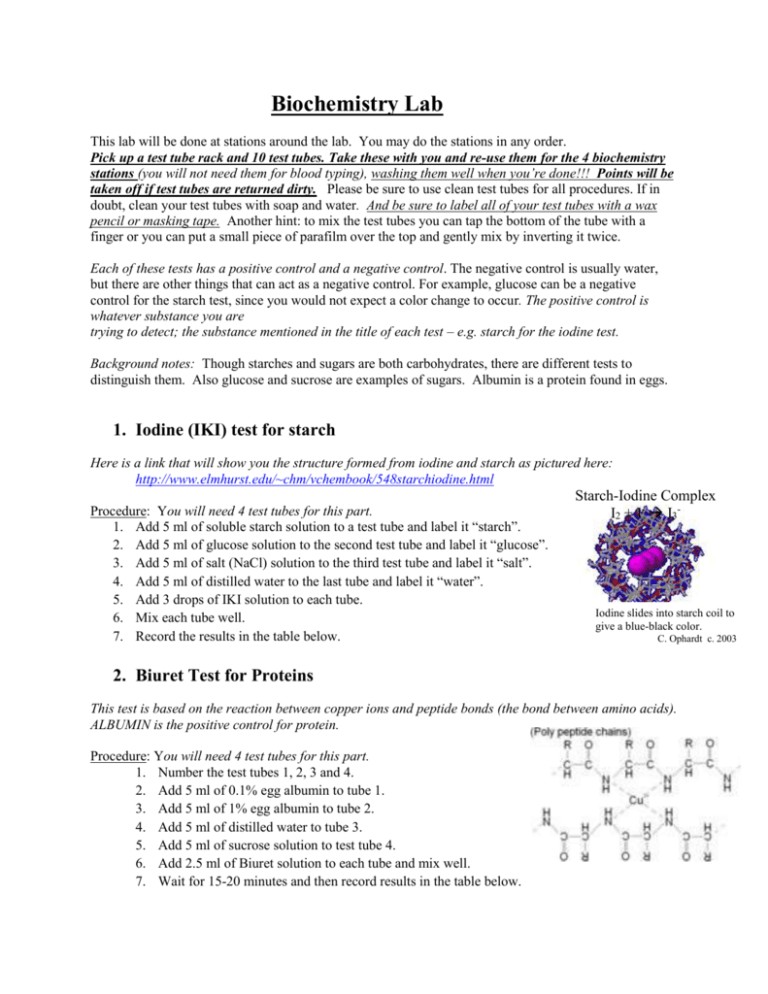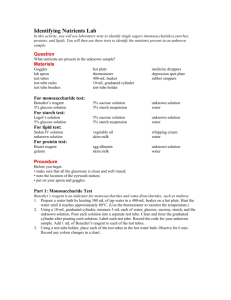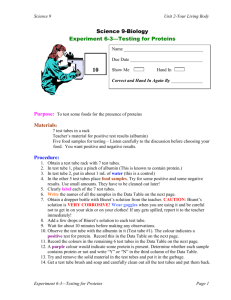Biochemistry Lab
advertisement

Biochemistry Lab This lab will be done at stations around the lab. You may do the stations in any order. Pick up a test tube rack and 10 test tubes. Take these with you and re-use them for the 4 biochemistry stations (you will not need them for blood typing), washing them well when you’re done!!! Points will be taken off if test tubes are returned dirty. Please be sure to use clean test tubes for all procedures. If in doubt, clean your test tubes with soap and water. And be sure to label all of your test tubes with a wax pencil or masking tape. Another hint: to mix the test tubes you can tap the bottom of the tube with a finger or you can put a small piece of parafilm over the top and gently mix by inverting it twice. Each of these tests has a positive control and a negative control. The negative control is usually water, but there are other things that can act as a negative control. For example, glucose can be a negative control for the starch test, since you would not expect a color change to occur. The positive control is whatever substance you are trying to detect; the substance mentioned in the title of each test – e.g. starch for the iodine test. Background notes: Though starches and sugars are both carbohydrates, there are different tests to distinguish them. Also glucose and sucrose are examples of sugars. Albumin is a protein found in eggs. 1. Iodine (IKI) test for starch Here is a link that will show you the structure formed from iodine and starch as pictured here: http://www.elmhurst.edu/~chm/vchembook/548starchiodine.html Procedure: You will need 4 test tubes for this part. 1. Add 5 ml of soluble starch solution to a test tube and label it “starch”. 2. Add 5 ml of glucose solution to the second test tube and label it “glucose”. 3. Add 5 ml of salt (NaCl) solution to the third test tube and label it “salt”. 4. Add 5 ml of distilled water to the last tube and label it “water”. 5. Add 3 drops of IKI solution to each tube. 6. Mix each tube well. 7. Record the results in the table below. Starch-Iodine Complex I2 + I- I3- Iodine slides into starch coil to give a blue-black color. C. Ophardt c. 2003 2. Biuret Test for Proteins This test is based on the reaction between copper ions and peptide bonds (the bond between amino acids). ALBUMIN is the positive control for protein. Procedure: You will need 4 test tubes for this part. 1. Number the test tubes 1, 2, 3 and 4. 2. Add 5 ml of 0.1% egg albumin to tube 1. 3. Add 5 ml of 1% egg albumin to tube 2. 4. Add 5 ml of distilled water to tube 3. 5. Add 5 ml of sucrose solution to test tube 4. 6. Add 2.5 ml of Biuret solution to each tube and mix well. 7. Wait for 15-20 minutes and then record results in the table below. 3. Benedict’s Test for Reducing Sugars (like glucose) A reducing sugar is one that contains a particular type of structure that reacts with the Benedict’s solution. It is commonly used to distinguish glucose (a monosaccharide) from sucrose (a disaccharide), but can distinguish many other types of sugars. Glucose is a reducing sugar. Procedure: You will need 4 test tubes for this part. 1. Start by making a hot water bath. 2. Label 4 test tubes: glucose, sucrose, starch and water. (You can use short hand or number them – somehow be sure you know which is which!) 3. To each test tube, add 5 ml of Benedict’s reagent, and add eight drops of the particular solution labeled on the test tube (either glucose, sucrose, starch or water) and mix well. 4. Heat all 4 test tubes in a boiling water bath for three minutes being careful not to boil the solution in the test tube. Remove with the test tube holders if necessary. 5. Allow the tubes to cool to room temperature. 6. Record the results in the table below. This is a qualitative measurement. You should record the color of the solution and if there is a precipitate (a precipitate is an opaque, solid that forms). 4. Tests for Lipids/Fats The Sudan test is based on the fact that Sudan III is a stain that dissolves in nonpolar stuff (like lipids), but not in polar stuff (like water and alcohol). The brown paper test works because lipids make paper more transparent – ie more light gets through. Procedures: A) Brown paper test 1. Cut 3 pieces of brown paper about 2 inches square each. 2. Put a drop or two of oil on one of the squares. Put a drop or two of sucrose solution on another square. Put a drop or two of water on the third square. 3. Hold each paper up to the light to determine amount of transparency. For this test, transparency is a positive result for lipids. On the results page, identify the amount of transparency as -, +, ++, +++ (none, very little, some, a lot) B) Sudan III test - You will need 3 test tubes for this part. 1. Number three test tubes 1, 2, and 3. 2. Add 3 ml of distilled water to tubes 1 and 3. 3. Add 3 ml of oil to tubes 2 and 3. 4. Using a toothpick add a VERY small amount of Sudan III to each tube and mix well by swirling the tube in your hands (DO NOT SHAKE). Record observations. Biochemistry Worksheet 1. Iodine (IKI) test for starch results: Observations (Color/intensity) Starch Glucose Salt Water 2. Biuret Test for Proteins results: Observations (Color/intensity) 0.1% albumin 1.0% albumin Water Sucrose 3. Benedict’s Test for Reducing Sugars results: Observations (Color/intensity & presence of precipitate) Glucose Sucrose Starch Water 4. Tests for Lipids/Fats results: Brown paper test results: Transparency Oil Water Sucrose Sudan test results: Color/intensity Water alone Oil alone Water and oil Questions: 1. Wash your test tubes. There are test tube brushes and soap at the sink. GET YOUR INSTRUCTORS INITIALS HERE FOR CLEAN TEST TUBES (this is worth points!) 2. For each of these tests, what is the positive control and what is the negative control? (Read the intro of the lab before asking for help!) Negative control Positive control (hint: it was the same every time!) IKI (starch) Benedict’s (reducing sugar) Biuret (protein) Sudan (lipid) Brown paper (lipid) 3. In general, are color tests presumptive or confirmatory? Explain why.






